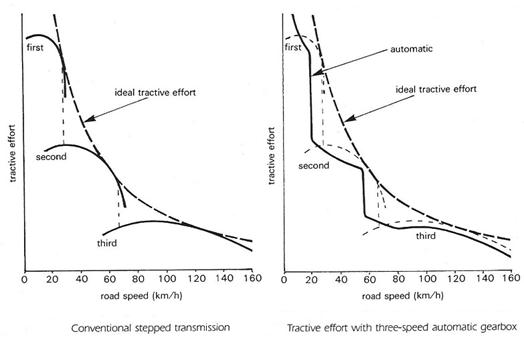Types of Tranmssions (gearboxs)
|
Sliding Mesh Mnaual Transmisson (spur gears) |
|
|
|
Constant Mesh Manual Trnasmssion (helical gears) |
|
|
|
Synchromesh mechanism |
|
|
|
|
|
Selector Mechanism |
|
|
Synchromesh
and selector mechanism
Most
modern manual-transmission vehicles are fitted with a synchronized gear box.
Transmission gears are always in mesh and rotating, but gears on one shaft can
freely rotate or be locked to the shaft. The locking mechanism for a gear
consists of a collar (or dog collar) on the shaft which is able to slide
sideways so that teeth (or dogs) on its inner surface bridge two
circular rings with teeth on their outer circumference: one attached to the
gear, one to the shaft. When the rings are bridged by the collar, that
particular gear is rotationally locked to the shaft and determines the output
speed of the transmission. The gearshift lever manipulates the collars using a
set of linkages, so arranged so that one collar may be permitted to lock only
one gear at any one time; when "shifting gears", the locking collar
from one gear is disengaged before that of another is engaged. One collar often
serves for two gears; sliding in one direction selects one transmission speed,
in the other direction selects another.
In a synchromesh gearbox, to correctly match the speed of the gear to that of the shaft as the gear is engaged the collar initially applies a force to a cone-shaped brass clutch attached to the gear, which brings the speeds to match prior to the collar locking into place. The collar is prevented from bridging the locking rings when the speeds are mismatched by synchro rings (also called blocker rings or baulk rings, the latter being spelled balk in the U.S.).
|
Automatic Transmission (Planetary gear sets) |
|
|
Automatic Transmissions
An
automatic (also called automatic gearbox, or auto transmission)
is one type of motor vehicle transmission that can automatically change gear
ratios as the vehicle moves, freeing the driver from having to shift gears
manually. Most automatic transmissions have a defined set of gear ranges, often
with a parking pawl feature that locks the output shaft of the transmission.
The predominant form of automatic transmission is hydraulically operated; using a fluid coupling or torque converter, and a set of planetary gear sets to provide a range of gear ratios.
Conventionally, in order to select the transmission operating mode, the driver moves a selection lever located either on the steering column or on the floor. Vehicles conforming to US Government standards must have the modes ordered P-R-N-D-L (left to right, top to bottom, or clockwise).
Any planetary gearset has three main components:
- The sun gear
- The planet gears and the planet gears' carrier
- The ring gear
Each of these three components can be the input, the output or can be held stationary. Choosing which piece plays which role determines the gear ratio for the gearset.
|
continuously variable transmission (CVT) |
|
|
Continuously Variable Transmission (CVT)
A
is a transmission that can change steplessly through an infinite number of
effective gear ratios between maximum and minimum values. This contrasts with
other mechanical transmissions that offer a fixed number of gear ratios. The
flexibility of a CVT allows the driving shaft to maintain a constant angular
velocity over a range of output velocities.

CVT can provide better fuel economy than other transmissions by enabling the engine to run at its most efficient revolutions per minute (RPM) for a range of vehicle speeds. It can also be used to build kinetic energy recovery system.
Alternatively it can be used to maximize the performance of a vehicle by allowing the engine to turn at the RPM at which it produces peak power. This is typically higher than the RPM that achieves peak efficiency. Finally, a CVT does not strictly require the presence of a clutch, allowing the dismissal thereof. In some vehicles though (e.g. motorcycles), a centrifugal clutch is nevertheless added, however this is only to provide a "neutral" stance on a motorcycle (useful when idling, or manually reversing into a parking space).
Transmission type’s comparison

Increasing the number of transmission ratios will make the car tractive effort curve of stepped transmission approximately similar to the ideal tractive effort. Using the CVT system with infinite reduction ratios the car tractive effort will coincide with the ideal one.






